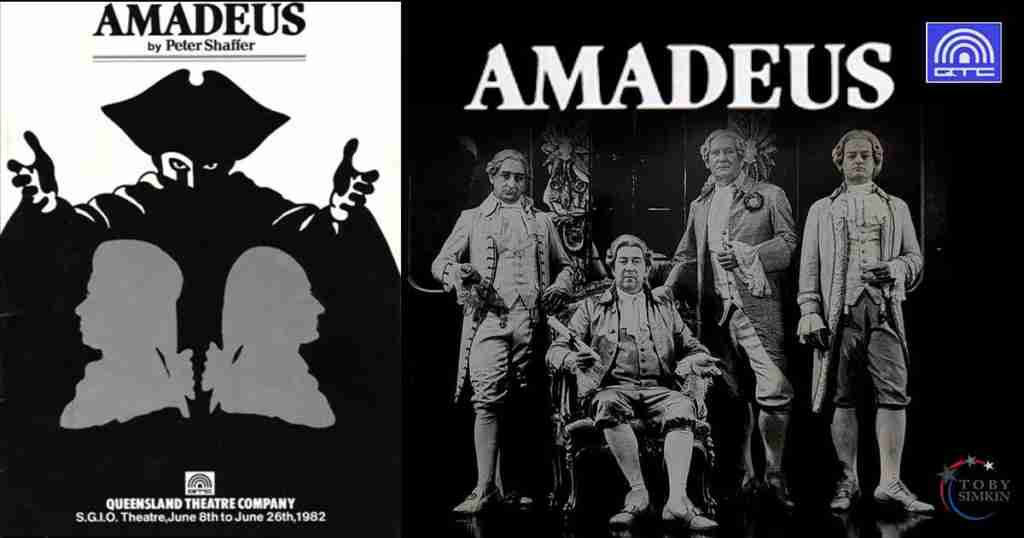Amadeus (Broadway)
AMADEUS by Peter Shaffer opened December 15, 1999 and closed May 14, 2000 at the Music Box Theatre on Broadway after 10 Previews and 173 Performances.
Produced by Kim Poster, PW Productions Ltd., Adam Epstein, SFX Theatrical Group and Center Theatre Group / Ahmanson Theatre (Gordon Davidson, Artistic/Producing Director); Produced in association with Back Row Productions and Old Ivy Productions; Associate Producer: Bradley R. Bernstein and Marc Epstein
Directed by Peter Hall; Designed by William Dudley; Lighting Design by Paule Constable; Sound Design by Matt McKenzie; Associate Lighting Design: Tony Simpson; Associate Scenic Design: Nancy Thun.
Starring Cindy Katz (Constanze Weber); Michael Sheen (Wolfgang Amadeus Mozart); David Suchet (Antonio Salieri); Jeffrey Bean (Servant); Glynis Bell (Teresa Salieri); Geoffrey Blaisdell (Servant); Jake Broder (One of the “Venticelli”); Charles Janasz (One of the “Venticelli”); Michael Keenan (Baron van Swieten); J.P. Linton (Count Johann Kilian Von Strack); Robert Machray (Salieri’s Cook); Dan Mason (Servant); David McCallum (Emperor Joseph II); Kate Miller (Katherina Cavalieri); Kevin Orton (Servant); John Rainer (Major Domo / Servant); Terence Rigby (Count Orsini-Rosenberg); William Ryall (Salieri’s Valet / Servant) and John Towey (Guiseppe Bonno) with standby Rocco Sisto (Antonio Salieri) and with understudies Jeffrey Bean (Salieri’s Cook, Guiseppe Bonno), Glynis Bell (Katherina Cavalieri), Geoffrey Blaisdell (Major Domo, Salieri’s Valet), Jake Broder (Wolfgang Amadeus Mozart), Charles Janasz (Antonio Salieri), Robert Machray (Baron van Swieten), Dan Mason (One of the “Venticelli”), Kate Miller (Constanze Weber, Teresa Salieri), Kevin Orton (One of the “Venticelli”), John Rainer (Count Orsini-Rosenberg), Brian Rardin (Servant), William Ryall (Count Johann Kilian Von Strack) and John Towey (Joseph II)
General Manager: 101 Productions, Ltd.; Company Manager: L.A. Glassburn; Production Stage Manager: Susie Cordon; Production Manager: Peter Fulbright; Stage Manager: Allison Sommers; Assistant Stage Manager: Brian Rardin; Technical Supervisor: Tech Production Services, Inc., Elliot Bertoni and Eric Hansen; U.K. Casting: Gillian Diamond; U.S. Casting: Pat McCorkle; U.K. Marketing: A. K. A. Ltd.; U.S. Marketing: The Nancy Richards Group; Online Marketing: Toby Simkin / Theatre.com Inc.; Press Representative: Boneau / Bryan-Brown.
As Founder and CEO of Theatre.com and BuyBroadway.com. The pioneer in moving the Broadway industry onto the internet. The theatre press branded me as “Toby is the man pushing theatre, kicking and screaming, into cyberspace.” What started in 1989 as a Broadway industry service called ShowCall via dialup BBS for members of the League of American Theatre Producers evolved onto the world wide web in the early 90’s, and shortly after this, the vast majority of Broadway shows (starting with my production of Victor/Victoria) and theatrical organizations followed. The “Super site of Broadway” became a publicly traded company, prior to my re-branding it as Theatre.com at the Minskoff Theatre.
Described by Variety Magazine as a “marketing powerhouse“, it was the single largest theatre community in the world with over 180,000 active members (in the 1990’s this was massive). From buying official Broadway tickets and souvenirs, providing detailed global show listings, interactive show study & educational guides, live streaming shows and events (including many Opening Nights live broadcasts), industry news from major theatre journalists, pictures and videos, games, messaging directly to Broadway cast’s backstage or even licensing a musical, theatre.com offered it all in a single, easy-to-use interface to theatregoers globally.
The play explored the rivalry between Wolfgang Amadeus Mozart and Antonio Salieri, the court composer for the Emperor of Austria in the late eighteen century.
Amadeus begins in 1823 on the day that the elderly Salieri believes will be his last. Once a composer in the Austrian court of Emperor Joseph ll, his musical compositions have now been branded as mediocre and he is all but forgotten. Addressing the audience as “Ghosts of the Future,” he narrates and reenacts his relationship to Mozart. Many years earlier, Salieri recognized the genius of the young Mozart, who arrives at the court as a famous musical prodigy. Envy burns in the once pious Salieri, who renounces God and sets out to completely destroy his rival.

![Amadeus (Broadway) [Poster] Amadeus (Broadway)](https://tobysimkin.com/wp-content/uploads/Amadeus-Broadway-Poster-1-201x300.jpg)










